- Searchers: People who type search queries into search engines
- Search engines: Programs that searchers use to find products, services, content, and more on the Internet
- Marketers: The owners or managers of websites and other channels that publish content and make offers to people on the Internet
Understanding searchers’ needs
The key for both marketers and search engines is understanding the mindset of searchers. By understanding what motivates searchers, marketers and search engines can serve them better.People use search engines every day for everything from researching a school project to looking for reviews for a big-ticket purchase like a car or home. What motivates searchers is simple: They want to find the most relevant, highest-quality web pages about anything and everything they’re searching for, and they want to find those pages now.
If marketers and search engines can satisfy searchers, everyone wins. Searchers find what they want; marketers get traffic, leads, and sales; and search engines gain users.
Knowing what search engines want in keywords
A search engine company, such as Google, is a business, and like any other business, it must generate revenue to survive. As a result, it’s useful to understand how search engines generate that revenue. If you understand what motivates the search engine, you can plan your search strategy accordingly.Most search engines generate most of their revenue by selling advertising. The image below shows a typical set of advertisements in a Google search results page.
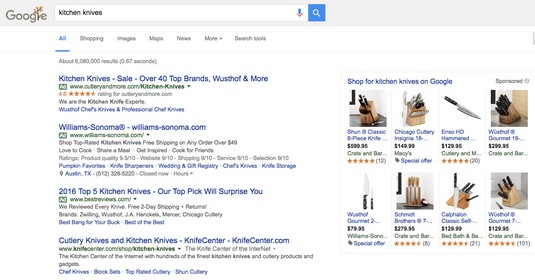 Source: www.google.com
Source: www.google.comGoogle displays ads at the top and in the top-right corners of search result pages.
As a result, it’s in a search engine’s best interest to serve the best, most popular, most relevant content to searchers. Failure to deliver what searchers want sends those searchers elsewhere to find what they’re looking for, which means less opportunity to show ads, which reduces its ability to ask for high advertising rates.
Other search engines generate revenue by establishing affiliate relationships with the businesses to which they refer traffic. When a searcher visits one of these affiliate partners and makes a purchase, the search engine makes a commission on that sale.
Black hats and white hats in search engine marketing
If you want to build a successful search marketing campaign, you need to stay within the borders of each search engine’s terms of service. Search marketing tactics that violate those terms of service are called black hat; those that play within the rules are called white hat.Black hat search marketing tactics are not only unethical (and sometimes illegal), but also bad for business. Violating the terms of a search engine may create short-term results, but those results won’t be sustainable. Search engines like Google continuously update the algorithms they use to rank websites in an effort to squash black hat methods such as link buying and keyword stuffing.
Marketers who use white-hat search marketing strategies — those who follow the search engine’s terms of service and build a better user experience for searchers — are rewarded with higher rankings and more traffic, leads, and sales from search engines.
Targeting keywords in search engine marketing
One way that people discover your business, brands, products, and services is by using search queries typed in search engines. A searcher navigates to a search engine, types a keyword or phrase, and taps or clicks a search button, and the search engine returns popular, relevant results. The searcher clicks or taps one of those results, and he’s off to the races.To help make your brand discoverable and available to a searcher, marketers have two broad categories of search queries to keep in mind:
- Branded queries: Keywords or keyword phrases that searchers type in search engines when they’re looking for a specific business, brand, product, or service. The search query “Southwest Airlines,” for example, is a branded query that Southwest Airlines should target.
- Nonbranded queries: Keywords or keyword phrases that searchers type in to search engines when they’re not looking for a specific business, brand, product, or service. The search query “fly to Chicago,” for example, is a nonbranded query that Southwest Airlines should target.
Suppose that a searcher is looking for a bed-and-breakfast inn, and she types the search query “historic bed and breakfast near me” in Google. This query is a nonbranded search query. The searcher isn’t looking for a particular bed-and-breakfast; she’s simply researching and discovering historic bed-and-breakfasts nearby.
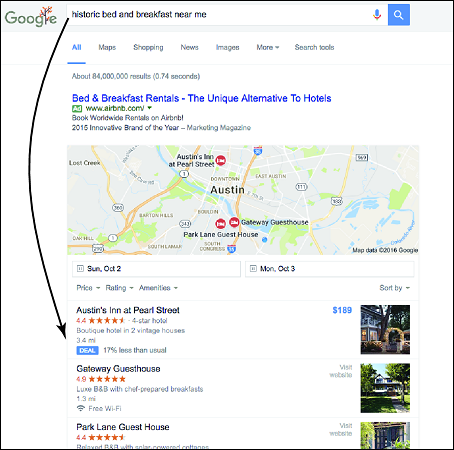 A discoverable search query for local bed-and-breakfast inns.
A discoverable search query for local bed-and-breakfast inns.
On the other hand, the searcher might be searching for a specific bed-and-breakfast, such as Austin’s Inn at Pearl Street, in which case she types a query such as “reviews of Austin’s Inn at Pearl Street.” This query is a branded search query.
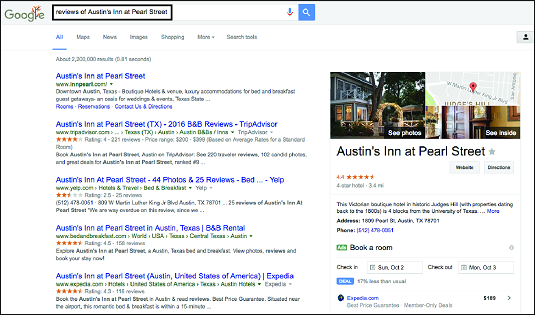 A branded search query for Austin’s Inn at Pearl Street.
A branded search query for Austin’s Inn at Pearl Street.
What is a search query?
Each of the billions of search queries entered in search engines each day contain the intent and context of an individual searcher. Intent, as it relates to search marketing, involves understanding what the searcher is looking for. The context of the query is made up of the reason why the searcher has that intent. In other words, intent is the “what” of a search query, and context is the “why.”Following are examples of intent and context of three people who might be searching the Internet:
- Person 1: I want to start a vegetable garden because I want to add organic food to my diet.
- Intent: Want to start a vegetable garden.
- Context: Add organic food to my diet.
- Person 2: I want to start a vegetable garden because I want to spend more time outdoors.
- Intent: Want to start a vegetable garden.
- Context: Spend more time outdoors.
- Person 3: I want to start a vegetable garden because I want to save money on grocery bills.
- Intent: Want to start a vegetable garden.
- Context: Save money on groceries.
A search marketer should focus on satisfying both the intent and context of searchers. Each intent and context represents a query worth targeting. In the preceding examples, searchers might type any of the following queries in a search engine:
- “start a vegetable garden” (intent only)
- “add organic food to my diet” (context only)
- “start an organic vegetable garden” (intent and context)
Choosing the right queries to target
Each query typed in a search engine contains the searcher’s intent and context, or both. To determine the intent and context that your ideal customer is typing in search engines, you need to do keyword research, using tools such as Google AdWords Keyword Planner.Coming up with keywords the “old-fashioned” way
Before you start using keyword tools, one of the best ways to do keyword research is to brainstorm ideas with anyone who comes into contact with your customers. After all, you know your customers' wants, needs, and pain points better than a keyword tool does. Gather the appropriate members of your team to answer questions about your customers.This will help you come up with relevant and specific keywords and keyword phrases to research with a keywords tool. After you have completed the brainstorming phase, move on to your respective keyword tool to see what keywords and phrases will work best for your search marketing campaign.
To help with your brainstorming, answer questions like these in the subsequent example. Following are examples of how online shoe retailer Zappos might answer questions to sell shoes to people who plan to run a marathon:
- Q: What is our ideal customer researching before he buys our product or service?
A: The ideal diet for a marathon runner.
- Q: What is our ideal customer interested in that’s related to our product or service?
A: Treating sore leg muscles.
- Q: What barriers does our ideal customer need to overcome before she buys our product or service?
A: Finding time to train for a marathon.
- Q: What does our ideal customer hope to accomplish with our product or service?
A: Running a marathon.
- Q: What information does our ideal customer need to evaluate our product or service against our competitors’ products or services?
A: Compare the weight of Nike and Adidas running shoes to train for a marathon.
- Q: What information does our customer need to buy our product or service?
A: The shoe-return policy.
Using keyword research tools to optimize your content for search marketing
After brainstorming, you move on to your chosen keyword research tool. Dozens of good keyword research tools are available for purchase, but the free Google AdWords Keyword Planner meets the needs of most search marketers. Google provides this free tool to allow advertisers to research the behavior of searchers who use its search engine. Advertisers use the information provided by this tool to choose keywords they bid on.The Keyword Planning tool is free, but you need to sign up for an Adwords account to use it.
Typing a keyword phrase like “run a marathon” in the Keyword Planner tool returns several keywords to target:- “running event”
- “marathon runner”
- “marathon tips”
The Google AdWords Keyword Planner gives you the following information about each query:
- Average monthly searchers: The average number of times people have searched for this exact keyword based on the date range and targeting settings that you selected.
- Competition: The number of advertisers bidding on this keyword or keyword phrase for a paid traffic campaign. In the Competition column, you can see whether the competition for a keyword idea is low, medium, or high.
Don’t be discouraged if you research keywords and find that the Google AdWords Keyword Planner has no information to report. The main reason to use this tool is to research keywords to target on Google’s advertising platform. Keywords that may be absolutely relevant to your business, and thus good keywords to target, may not appear in this tool, particularly for branded queries such as the names of your products, services, or brands.
Satisfy searchers with the right keywords and SEO tactics
Much like bloodhounds on a hunt, people often search the web until they satisfy their intent, context, or both. To compete for a search query, a marketer needs to create a web page or asset that satisfies the searcher’s query. That web page or asset could be anything from a blog post to a product demonstration video.The web page shown in below satisfies the intent of any searcher who enters the query “mojito recipe” in the Google search engine.
The web page shown below satisfies the intent of a searcher who enters the query “buy canon eos 70d” in the Amazon search engine.
Other assets you might create to satisfy the intent of a searcher include podcasts, videos, and social media updates.
The web page or asset needs to be discoverable by the search engine that the marketer is targeting. The Pinterest search engine, for example, discovers new Pinterest pins added to your Pinterest boards, and the Google search engine discovers new web pages and blog posts added to your website (assuming that you haven’t created any technical barriers for the search engine).
If the web page or asset you create satisfies the intent, context, or both of a searcher, it has a chance to be shown to that searcher. That said, many factors determine which web pages and assets are shown for any given query. The trick is to get the formula right so that you are providing the best content for the search query.SEO is an ever-evolving process. Use these resources to stay up to date on SEO.

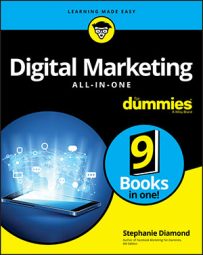
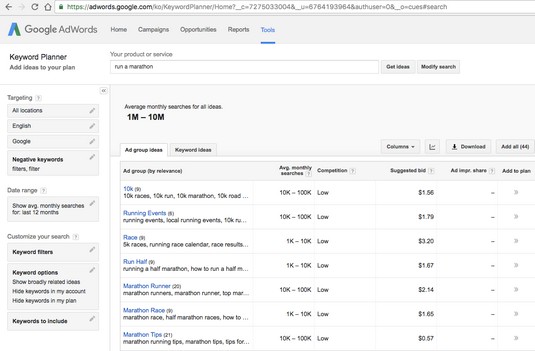 Source:
Source: 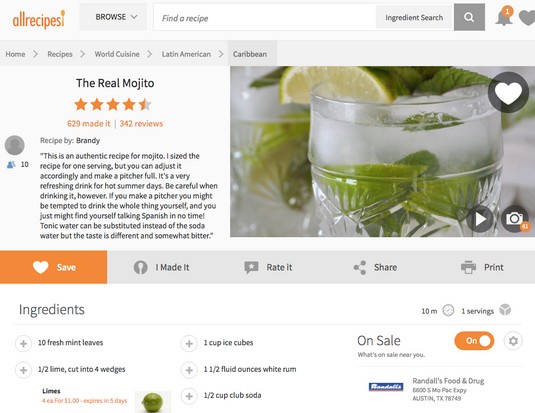 Source:
Source: 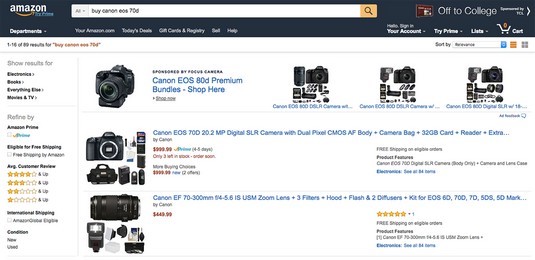 Source:
Source: